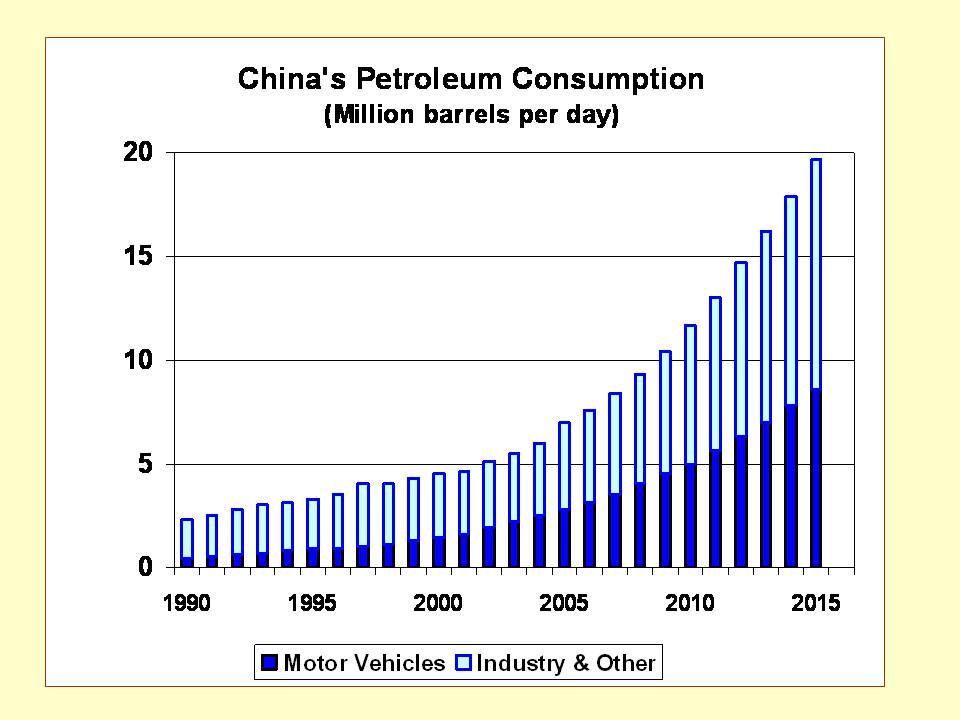China in 2015: 156 Million Vehicles Will Use a Lot of Oil

The Chinese have fallen in love with the automobile much like the American public did in the 1950s and 60s. As unlikely as it seems that a country could develop a deep affection for cars that don’t have monster engines, large tail fins, and can bury a 120 MPH speedometer without even vibrating, it appears to have happened. The energy consequences of China’s new “love affair” are considerable.
(PRWEB) October 10, 2005 -- Over the ten years ending in 2004 China’s stock of motor vehicles grew an average 14% per year to reach roughly 41 million: 28 million cars and 13 million trucks. A recent comprehensive forecast of the Chinese economy through 2015 by New Jersey economic consulting firm Business Restoration Partners suggests that the current 41 million vehicle number will likely reach 156 million by 2015—even with a somewhat lower growth rate.“
This surge in the number of vehicles on the road will boost China’s consumption of oil substantially,” states international economist James A. McCune of Business Restoration Partners. “By 2015 we expect China to be consuming 8.6 million barrels of oil per day just to fuel their autos and trucks,” continues McCune, “add that to commercial and industrial petroleum use and you are very near 20 million barrels per day.” (Go to http://www.business-restoration-partners.com/ to view the assumptions and Executive Summary of The CHINA REPORT: China’s Economy Through 2015.)
BRP’s recently released forecast of the Chinese economy discusses the country’s development prior to the year 2000 which saw energy consumption per unit of real economic growth decline rather sharply. Much of this decline had to do with shifts of agricultural workers from the farm to non-farm village enterprises, and also to the assembly-intensive nature of China’s new manufacturing plants.
According to the forecast, China’s current stage of development will not allow sluggish energy use going forward: “The dynamics between China’s economic development and her energy consumption have changed,” adds McCune, “since 2000 we have seen energy use per unit of real GDP rise significantly, and strong increases in auto consumption virtually assure this new dynamic will continue.”
China’s production of petroleum has increased at less than 2% per year over the past 15 or so years, and is not expected to rise much faster than that going forward, according to Business Restoration Partners. That means a significant increase in petroleum imports: “China’s petroleum needs over the next 10 years will drastically outstrip her ability to produce it,” states McCune, “Imports will rise from today’s 40% of consumption to almost 80%, or 15.7 million barrels per day, by 2015 . . . and this assumes coal’s share of China’s total energy consumption drops only six percentage points over the next 10 years. Should coal drop further, oil imports will be even higher.”
Persons interested in learning more about this comprehensive new forecast of the Chinese economy can read the Executive Summary at the firm’s website: http://www.business-restoration-partners.com/. Concerning the forecast, Mr. McCune adds: “The energy section of our recent forecast is the most interesting part of it, but second only to that is our projection for China to begin running a substantial trade deficit in just a few years . . . mainly because the rest of the world simply can’t grow fast enough to absorb the increasing flood of Chinese exports.”

0 Comments:
Post a Comment
<< Home